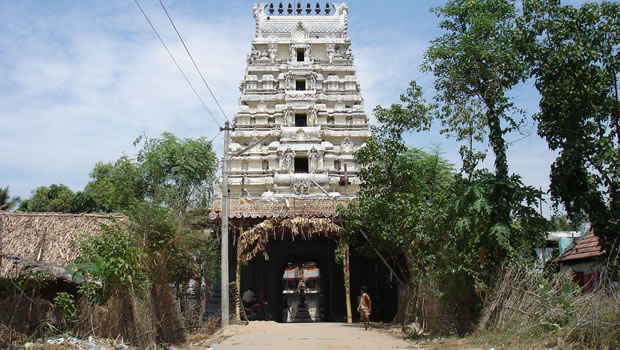Thirukoodalur Divyadesam familiarly worshipped as Aduthurai Perumal Koil is located around 25 kms from Kumbakonam on the way to Thiruvaiyaru via Swamimalai.
Thirukkoodalur Divyadesam is referred in both Bramanda Puranam and Padma Puranam. The presiding deity here in Thirukkoodalur is Vaiyam Kaththa Perumal - Perumal Who preserves the whole Universe and also worshipped as Uyyandavar and Jagath Rakshagan.
This is one of the Purana Sthalam and also Prarthana Sthalam. The temple is the Sangama Kshetram. Raja Gopuram was built up with five tiers. Thayar blessing as Padhmasani and Pushpavalli Thayar. Almighty appears as he is always ready to come to rescue all his devotees with HIS Chakra.
Moolavar - Vaiyam Kaththa Perumal, Jagath Rakshagan
Utsavar - Amabreesha Vardhan
Thayar - Padmasana Valli
Vimanam - Suddhastva Vimanam
Praised By - Thirumangai Alwar
Kshetram - Sangama Kshetram
Theertham - Chakra Theertham, Indhira Theertham
Jakath Rakshaka Perumal Temple or Thirukoodalur (locally called Aduthurai Perumal Temple) in Vadakurangaduthurai, a village in the outskirts of Kumbakonam in the South Indian state of Tamil Nadu, is dedicated to the Hindu god Vishnu.
Constructed in the Dravidian style of architecture, the temple is glorified in the Divya Prabandha, the early medieval Tamil canon of the Azhwar saints from the 6th - 9th centuries AD. It is one of the 108 Divyadesam dedicated to Vishnu, who is worshipped as Jakath Rakshaka and his consort Lakshmi as Padmasanavalli.
The temple is believed to have been built by the Medieval Cholas of the late 8th century AD, with later contributions from Vijayanagar kings and Madurai Nayaks. A brick wall surrounds the temple, enclosing all its shrines and bodies of water.Jakath Rakshaka is believed to have appeared to sage Nandaka and King Ambarisha.
Six daily rituals and three yearly festivals are held at the temple, of which the Brahmostvam, celebrated duringthe Tamil month of Vaikasi
(May - June), is the most prominent.
In this sthalam, all the devars along with Nandhagarishi was given the prathyaksham of Sriman Narayanan. Since all of them gathered (koodi) all together, this sthalam is called as "Thirukkoodaloor".
After coming to this sthalam only, the River Cauvery regained its speciality and holyness. Koodal + oor = Koodaloor. Koodal means joining (merging) together at the same place. Since, Cauvery is coming together in this Kshetram, this Kshetram is also called as "Sangama Kshetram".
Sangamam means joined together.Actually this divya desam is completely washed out by flood and the Lord Came in the dream of Rani Mangammal, who was the Queen of Madurai and told her that the temple was disappeared inside the earth.
On hearing this, Rani Mangammal ordered to take out the temple out of the earth and on her commandents only this temple was rebuild and taken care.The Utsavar in this temple is "Jegatharatshakan". As the name implies, he keeps the Baton in his hand.
Do:
- Do pray your Ishta Devata before pilgrimage to Temple.
- Do contact Temple Devasthanam information centre for enquiry, temple information and for Pooja details etc.
- Do reserve your travel and accommodation at Temple well in advance.
- Do bath and wear clean clothes before you enter the temple.
- Do concentrate on God and Goddess inside the temple.
- Do maintain silence and recite your Istamantram to yourself inside the temple.
- Do observe ancient custom and traditions while in Temple.
- Do respect religious sentiments at Temple.
- Do deposit your offerings in the hundi only.
Don't s:
- Do not come to Temple for any purpose other than worshipping of God and Goddess.
- Do not smoke at Temple.
- Do not consume alcoholic drinks at Temple.
- Do not eat non-vegetarian food in the Kshetram.
- Do not approach mediators for quick Darshanam. It may cause inconvenient to others.
- Do not carry any weapon inside the temple.
- Do not wear any head guards like helmets, caps, turbans and hats inside the temple premises.
- Do not perform Sastanga Pranama inside the Sanctum Sanctorum.
- Do not take much time while performing Sparsa Darshanam to God in Garbhagriha.
- Do not buy spurious prasadams from street vendors.
- Do not encourage beggars at Temple.
- Do not spit or create nuisance in the premises of the temple.
